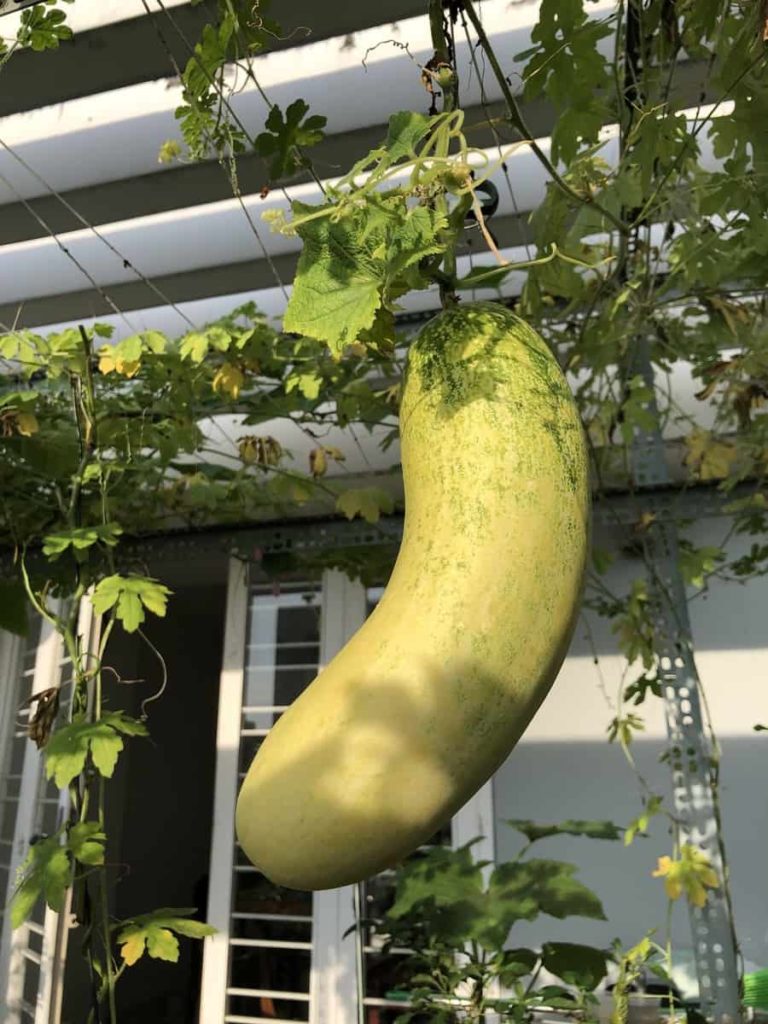Cucumbers are very friendly and thrive in different climates. Cucumbers are some of the most popular vegetables and are well-loved worldwide. They may be some of the easiest vegetables to grow at home in your garden. However, many problems can arise when growing Cucumbers on your own.
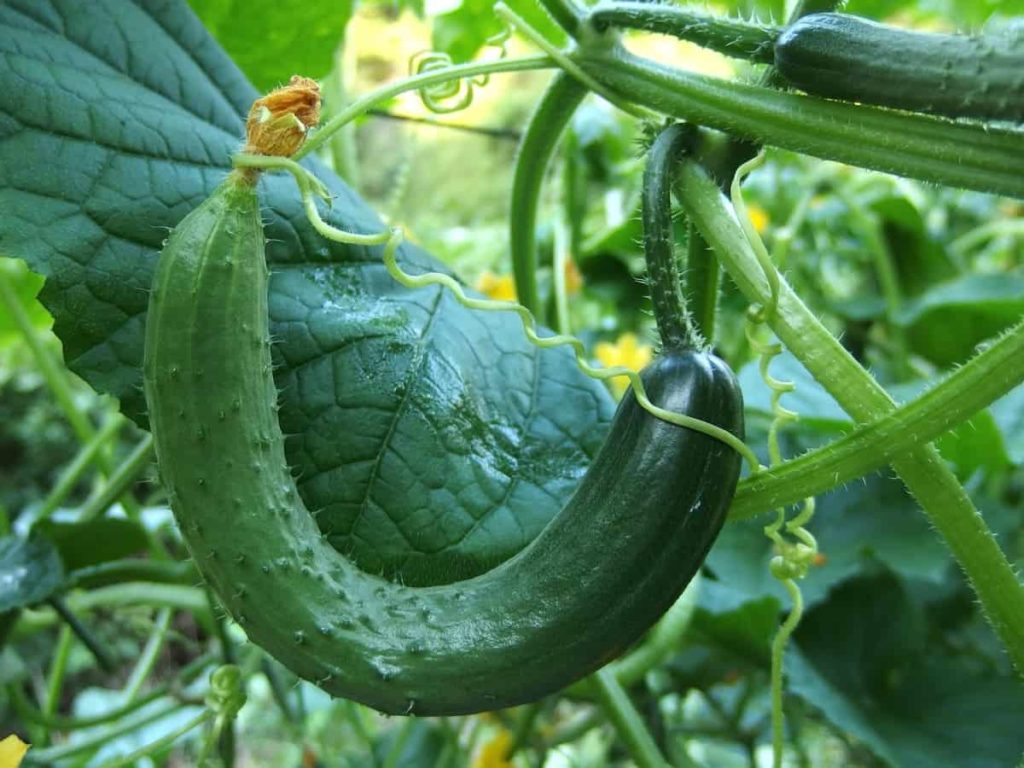
The biggest problems when growing Cucumbers are lack of flowers, white, yellow, or brown leaves, plants wilting or drooping, plants drying or curling, and total plant deaths. Fortunately, these problems are easily solved by using water and pesticides or fungicides. However, you should know how to treat and identify the issues in Cucumber plants, especially if you are new to growing your vegetables.
Common cucumber plant problems
Stunted growth
Planting problems
Poor planting methods can damage Cucumber plants and can cause growth problems.
Solution –Plants in a faraway place suffer from poor pollination, while plants very close to each other result in crowded, stunted plants. Space plants are 8 to 12 inches apart. Planting time is also a factor. If Cucumbers are planted early, they are slow to grow in cold temperatures. Vegetables need modified nutrient-rich soil with compost or manure for proper growth.
Weather
The weather plays a significant role in how well Cucumbers grow. Frost quickly damages Cucumber plants and can prevent growth or kill the plant completely.
Solution – Shade cloth blocking sunlight in the hottest part of the day relieves Cucumbers. Cucumbers need regular irrigation when planted, even as growth slows down, to avoid harvesting. Dehydration also causes bitterness in vegetables. Mulching helps in maintaining moisture in the soil.
Diseases
Verticillium wilt, bacterial wilt, and fusarium wilt diseases cause the death of vines, which completely slow or prevent Cucumber growth.
Solution – Crop rotation reduces the risk of these bacterial diseases. Removing diseased plants prevents the spread of uninfected Cucumbers. Cucumber beetles damage plants and spread disease. Controlling beetles from wood ash can provide healthy Cucumber plants that grow well.
Cucumber leaves are turning yellow
Deficiencies
By taking a soil test, you can find out what is lacking in your soil so you can modify it.
Nitrogen deficiency – It is common for Cucumber leaves to yellow when nitrogen is deficient. You must correct this problem, or the Cucumber plant may die.
Solution – The best and easiest way is to add nitrogen to the soil of your Cucumber plant and add a couple of tablespoons of fertilizer. Be sure to follow fertilizer instructions, as using too much can damage the plant and won’t produce Cucumbers. You may also try to add thin layers of compost around your soil.
Potassium deficiency – Cucumbers need an overdose of potassium when they start flowering. One possible sign that your Cucumber plant lacks potassium is leaves start turning yellow on the edges and tips.
Solution – Use a balanced fertilizer to solve this problem.
In case you missed it: Best Season to Grow Cucumber at Home in India: In Pots, Terrace, Apartment Balcony, and Backyards
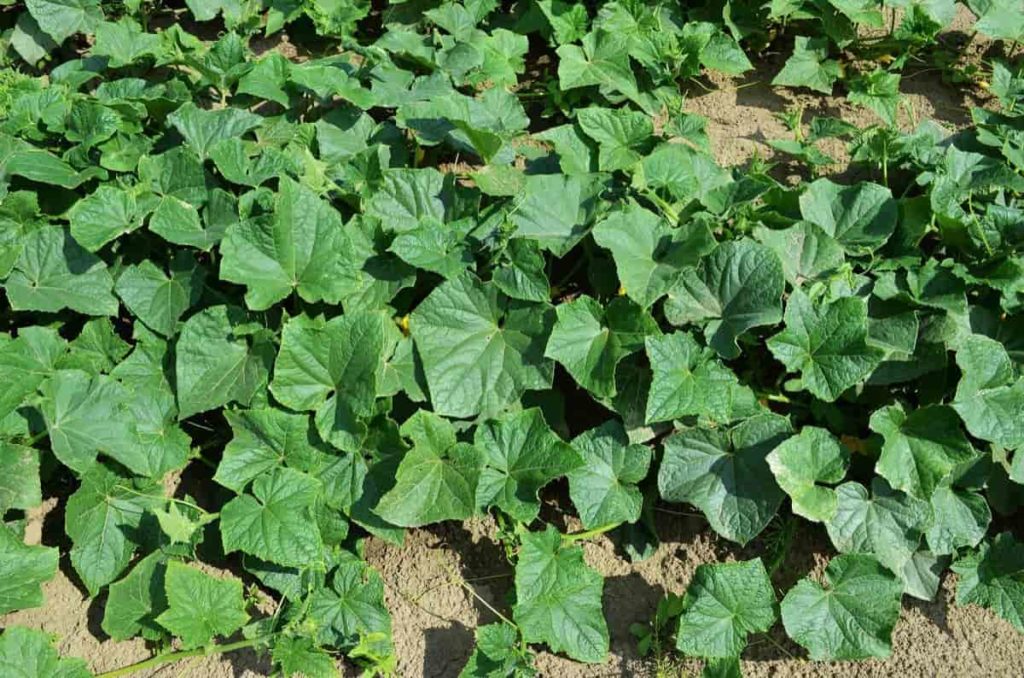
Iron deficiency – If your Cucumber plant is deficient in iron, you will see that the new leaves are yellow but green veins.
Solution – Spraying leaves on a Cucumber plant with liquid iron or spraying grained iron around the plant’s roots.
Plant diseases
Unfortunately, several diseases infect Cucumber plants, such as Cucumber mosaic virus, fusarium wilt, and Downy mildew.
Cucumber mosaic virus – You will have to remove the entire plant and any weeds that can harbor the mosaic virus of Cucumber. The Cucumber mosaic virus can remain in the soil and affect your plants next year. So be careful what and where you plant if this disease is your problem.
Fusarium wilt – Fusarium wilt fungus can be sustained for a long time in the ground. In the growing cycle, you can see fusarium wilt at any time; unfortunately, once the infected Cucumber plants get it, it is necessary to remove them.
Downy mildew – The good news is that Downy mildew can’t survive on plant debris. Plant Cucumber varieties that have more resistance to Downy mildew. Apply fungicides if you notice symptoms of damage. You have to catch it quickly to get the fungicides to work through. So, monitor your Cucumber plants closely. Remove any plants that have been affected.
Pests
Spider mites, white flies, and aphids all enjoy feeding Cucumber leaves. Unfortunately, when these insects do this, they can make Cucumber leaves yellow.
Solution – To prevent the damage, you can treat them with pesticides, use row covers, and encourage valuable insects such as minute pirate bugs, ladybugs to name a few,
Water problems
Another cause of yellowing of Cucumber leaves is due to water problems. Inconsistent water can cause problems.
Solution – Cucumber needs about 1 to 2 inches of water every week to thrive. Also, make sure you have good drainage where you plant your Cucumbers.
Not enough sunlight
Cucumbers love the sun. So, ensure they are planted in an area with at least 6 hours of sunlight daily.
Solution – Some do better when they get the 8-hour full sun.
Cucumber leaves are dying, but fruits are on the vines
Lack of moisture
Cucumber plants grow faster. As a result, plenty of water is needed to keep them healthy and help them to bloom and bear fruit. Leaves quickly wilt in the summer sun due to dehydration.
Solution – Water your Cucumbers once or twice a week, or whenever the soil feels dry to touch 1 inch below the surface. Irrigate the soil to root level for those grown in the garden, or even the water runs freely for Cucumbers grown in the container from the holes below the container.
Plant pests and diseases
Sometimes diseases cause Cucumber plant leaves to dry and die. Bacteria wilt and powdery and downy mildew all affect plant leaves. The first sign of bacterial wilt is the rapid wilting of leaves, and the leaves can eventually brown and die. Powdery or Downy mildew starts as spots on both leaves, which can lead to browning and dying of leaves. Anthracnose, leaf spot, and blight can brown the leaves of Cucumber plants and cause them to die.
Pest attack often damages Cucumber leaves, resulting in brown and dying leaves. In addition, cucumber beetles, squash bugs, and aphides usually attack Cucumber plants.
Solution – Prevent pests and diseases from getting strongholds in your garden by paying attention to sanitation and proper water. Remove the garden debris, keep the weeds under control, and mulch under your Cucumber plants. Closely monitoring your plants and handpicking pests, using horticultural soaps, or removing them from plants with a tremendous stream of water may require you to do everything you can to keep pests away.
In case you missed it: Best Fertilizers for Cucumber: Homemade, Organic, Liquid, NPK, and Schedule
Pour the neem oil mixture into a spray bottle and spray on the whole surface of the leaves. Water your Cucumbers early in the day to dry leaves before nightfall to avoid pests and diseases, as many thrive in damp conditions.
Cucumber leaves are getting dry and brown
Angular leaf spot
Angular leaf spot causes angular brown spots on the leaves. Spots can dry and brittle, falling away from leaves and causing large irregular holes.
Solution – Dry weather can prevent this disease. Every two years, save all the cucurbit family members from disease by rotating them to a new location in the garden.
Verticillium wilt
Verticillium wilt starts with yellow and brown wilted leaves. As the disease progresses, a brown discoloration may appear on a cross-section of roots. The entire plant can die after weeks of continuous decline.
Solution -Unfortunately, you cannot treat the verticillium wilt. Destroy affected plants and next year plant Cucumbers at a new location.
Moisture misstep
Cucumbers are shallow-rooted plants that will quickly suffer from drought and shows dry, brown, or yellow leaves.
Solution – Water Cucumbers deep so that at least 6 inches become moist. Water regularly at least once a week. Irrigation is essential when fruits are produced. In addition, you should keep a layer of organic mulch on the soil will help maintain moisture in the soil.
Wilting Cucumber leaves
Heat stress
Cucumbers sometimes wilt during high heat, especially when there are dry winds with heat. In these circumstances, leaves lose water more quickly than roots can take moisture from the soil.
Solution – To prevent wilting from heat stress, water more frequently. This is a time when the use of overhead sprinklers is appropriate and even desirable. Also, mulch the soil with straw or untreated grass clippings to preserve moisture and install cloth shade on plants.
Disease
Many diseases can cause wilting leaves, and these diseases are fatal in most cases. Verticillium causes wilting and lights brown streaks inside leaves and trunks.
Solution – Prevent disease by planting resistant varieties and rotating crops. Sudden wilting causes the leaves to wilt, and at the same time, the roots rot. To prevent this, add compost to improve drainage or plant Cucumbers in raised beds.
Pests
Most of the pests that attack Cucumbers leave visible damage by chewing leaves. However, a few may cause wilt. For example, squash bugs make tunnels through vines, causing leaves to wilt.
Solution – Lay boards in the garden to trap and kill adults. Find and destroy small eggs at the base of plants.
The aphids suck the juice from leaves and stems, causing stippling, curled, or wilted leaves. You may also notice honeydew on leaves and the ground, a sticky substance emitted by pests.
Solution – Spray with a steady stream of water on both the top and bottom of the leaves to treat the aphids.
Nematodes are microscopic roundworms that cause severe damage in the vegetable garden. These insects feed on the roots of Cucumber plants so that plants cannot take moisture and nutrients from the soil.
Solution – Crop rotation helps in controlling nematodes. In extreme cases, you may have to solarize the soil, which requires a clear plastic sheet to be spread firmly on the soil for four to six weeks during the summer heat. The high heat destroys the nematodes.
In case you missed it: Home Gardening in Karnataka: A Step-By-Step Guide for Outdoors, Indoors, Apartment Balcony, and Terrace
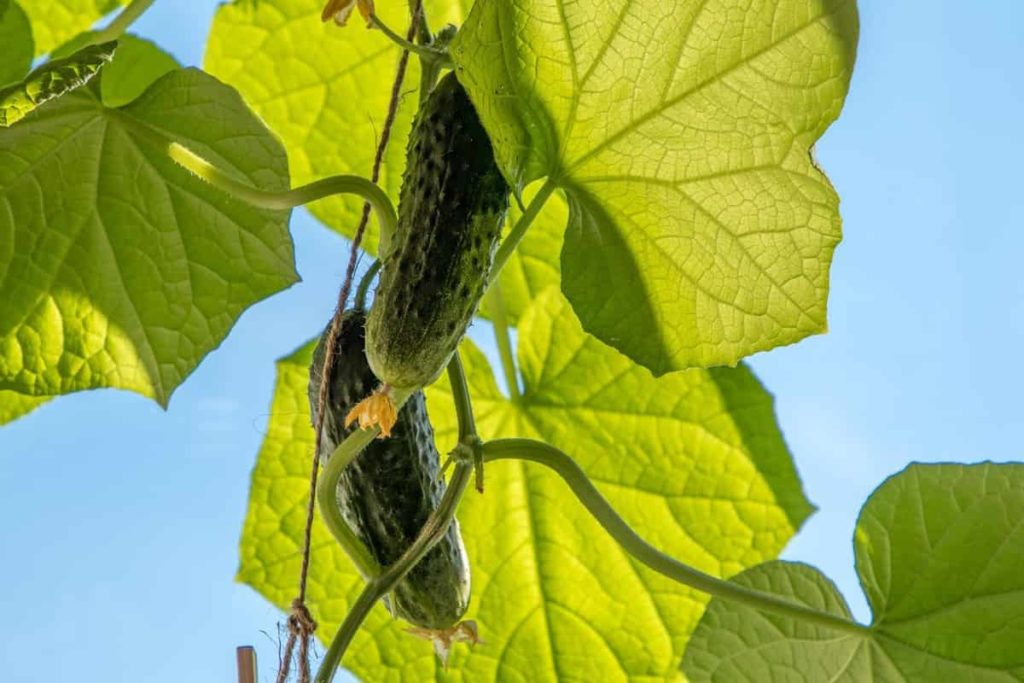
Cucumber flower drop
Male flowers falling from your Cucumber plant are normal. Male flowers often fall before the female flowers are produced or before the fruit is set. Later blooms also drop once they spend their pollen. The female flowers are produced once the second flush of male flowers appears but do not drop. The female blooms falling from your Cucumber plant usually indicate that something prevents successful pollination.
Solution – Severe climate conditions, such as high heat or cold, can cause a lack of pollinating activity. In addition, some commonly used pesticides, such as carbaryl are toxic to flies and can reduce the population around the plants. If pesticide use is necessary, try to use them time in cold periods or when flies are not active to affecting.
Home gardeners can compensate for bees and other pollinators by pollinating their Cucumbers themselves and preventing female flowers from falling. Paintbrush transfer pollen from male to female flowers or cotton swabs. Increase the pollinated insect population using fellow plants such as Cilantro, Yarrow, White Sweet Clover, and Spearmint. These plants attract natural pollinators and other beneficial insects, including natural predators of destructive insects.
Cucumber flowers but no fruit
Cucumber plants will flower, but if there is a shortage of male or female flowers on the plant, then it will produce no fruit. Poor pollination will also lead to a lack of fruits. Pollination and flower production is affected by growing conditions affect.
Lack of female flowers
Male flowers appear on Cucumber plants before the female flowers. Therefore, cucumber plants should start producing fruit crops after the female flower appears. However, high temperatures can cause some female flowers to abort if you plant them too late.
Solution – Cool temperatures encourage female flowers to form early and stay on the plant. However, cool temperatures can discourage the formation of male flowers early in the season. So, keep your plants cool if you want to grow female flowers in Cucumbers. To encourage female Cucumber flowers, plant them out where it is cool. If necessary, give them a little shade in the hottest part of the day to protect them from the sun’s heat.
Lack of male flowers
The lack of male flowers on the Cucumber plant can also be a problem. The possibility of male flower deficiency is most likely to be Cucumber varieties. A gynoecious type produces most (or all) female and very few (or not) male flowers.
Solution – One solution is to plant gynoecious Cucumber plants. Then, plant a small number of seeds from various monoecious Cucumbers. This will ensure enough male flowers to provide plenty of pollen. It will also give you lots of fruits. Also, remember that high temperatures encourage male flowers to form.
Lack of pollination
Even if you have enough male and female flowers on your Cucumber plant, there may still be delays in setting the fruit. This is because Cucumbers are not pollinated: they need flies carrying pollen from male to female flowers. Without proper pollination, you cannot have lots of fruit sets. Flies often carry pollen from male flowers to female ones to pollinate Cucumber plants.
Solution -There are several ways to pollinate Cucumber flowers. You can hand pollinate yourself or use a brush or a cotton swab to pollinate.
Temperature and weather
Temperature matters when it comes to flowering for Cucumber plants. When it is hot, the Cucumber plant produces more male flowers. The Cucumber plant produces more female flowers at cool temperatures. Different types of Cucumber also affect how the plant reacts to different temperatures.
In case you missed it: Growing Cucumber Hydroponically, Nutrient Solution
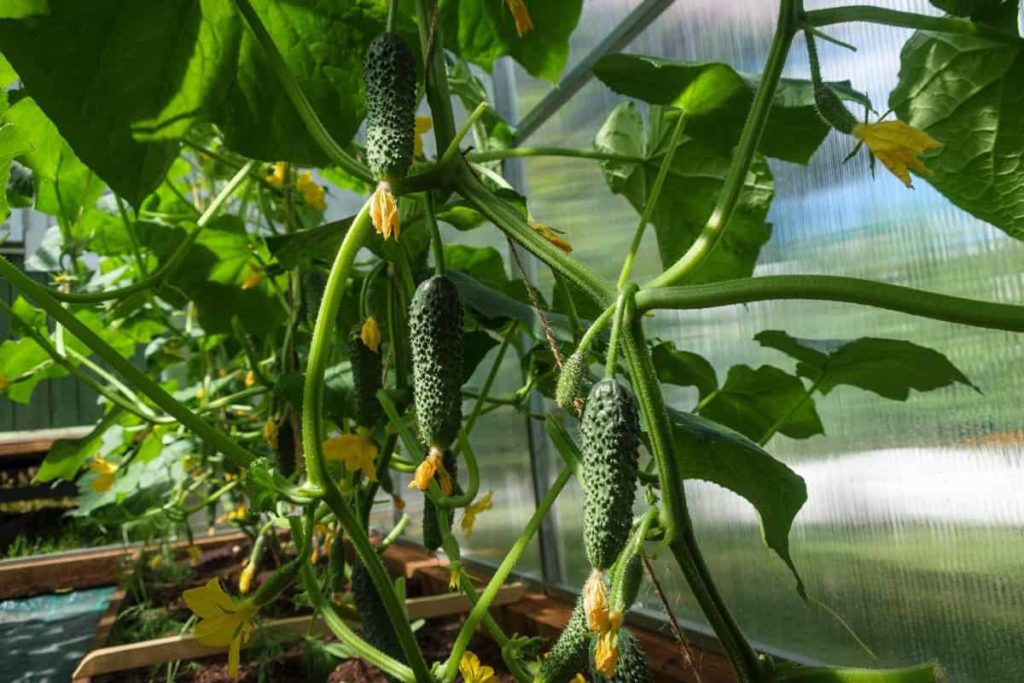
Solution – The rainy season can prevent flies from doing their job. The result is fewer pollinated flowers and fewer fruits.
Nitrogen levels in the soil
Excessive nitrogen intake can burn plants, especially when applied simultaneously. However, too much nitrogen can also affect Cucumber plants: a delay in flowering production.
Solution – In other words, too much nitrogen causes green growth at the expense of flowers and fruits. Too much nitrogen can also cause the lack of female flowers in Cucumber plants. High nitrogen is often caused by heavy consumption of concentrated fertilizers with high nitrogen fertilizer or high nitrogen content.
Pests
Aphids
Aphids are soft-bodied pests that like to hang under plant leaves and trunks. Most aphids are green or yellow, but others are pink, brown, red, or black.
Solution – If the plants are strong and healthy, spray them with a strong water jet to remove the aphides from the leaves. Prune out the branches and leaves that are heavily affected by the Aphids. Pesticides are needed to treat this problem in extreme conditions.
Cabbage Loopers
Cabbage loppers chew holes in the leaves, and the damage can be wide. Sometimes you see some small holes, and sometimes you will have extensive damage that will destroy the leaves.
Solution – Leave natural enemies, such as the parasitic wasps, back to control the looper population. Remove eggs and worms from the plant or trim the affected parts.
Cucumber beetle
Cucumber beetles feed Cucumber plants, holes in your plant leaves and flowers. Larvae eat plant roots.
Solution – Plant beetle-resistant types. Cover the plants with floating row cover after the seeds germinate until they start to flower. Then, remove it, and allow the pollinators to access your plants. Trap the beetles with yellow sticking traps. This method also traps pollinating and beneficial insects.
Cutworms
The cutworm larvae are activated at night and hide during the day, making it difficult to find these pests. They hide in soil or plant debris.
Solution – Be sure to eliminate all plant debris after harvesting or two weeks before planting. Properly spread the diatomaceous earth around the plant base and you can also apply pesticides to affected areas with severe diseases.
Flea Beetles
These insects leave small holes or pits in the leaves, and this damage can lead to less plant growth. As a result, plants die from severe diseases.
Solution – If you face an attack of flea beetles, using a floating row cover before an attack can help prevent the emergence of flea beetles. Trap crops nearby as a preventive measure. Apply a single layer of mulch underneath your plants to avoid them.
Whiteflies
Whiteflies stick to the bottom of the leaves and feed the plant juice. These insects cause plant death, and infected plants lead to low production.
Solution – Use floating row covers to avoid white flies searching for your plants. Spread reflective mulch around the base of your plants to keep white flies away from their plants. Clean any crop debris and keep your garden beds clean to avoid problems.
Diseases
Alternaria Leaf blight
The disease usually affects mature leaves. You may see small, brown spots first. These brown spots can grow in irregular forms with a yellow halo. Immediately after that, the leaves turn brown and die, causing the fruits to encounter sunlight that can burn them directly.
Solution – Fungicides are the only way to treat fungal diseases. You can also try spraying homemade fungicides from soapy water, baking soda, and vinegar. If a few parts of the plant are affected, cut these parts off and remove them so that you can avoid fungus spreading.
In case you missed it: Cucumber Seed Germination, Time, Period, Temperature

Anthracnose
You may see round, yellow spots on leaves that are small at first but grow larger as the disease progresses.
Solution – Spray fungicides as per instructions on the product label. Chlorothalonil and benomyl are popular fungicides used to treat anthracnose.
Powdery mildew
Affected plants show white, powdery fungal growth on the trunks and leave, especially on the surface of leaves. The white powder edifying white spots or layers on the leaves of the stem are a special symbol of powdery mildew. Fruits can also be affected, although it is rare.
Solution – Spray chemical or organic fungicides and remove the parts of the affected plants. Treating powdery mildew can be easier than other fungal diseases. The common method of spraying fungicides and removing infected plant parts still applies, but many organic treatment options are equally effective.
Conclusion
It may seem difficult to identify and manage problems with your Cucumber vines. But the truth is that you will get many years more success than you will have problems. Cucumbers are not the most turbulent plant in your vegetable garden, but they are also not easy to grow. If you are aware of pests and diseases that can attack these garden favorites, you will get a better chance of a bountiful harvest.
- Flower Garden Designs and Layouts for Beginners
- Planting and Spacing Techniques in Papaya: A Beginner’s Guide
- Growing Gold: Essential Techniques for Planting Pineapples
- How to Make Kalanchoe Plant Bushy: Home Remedies and Solutions
- 11 Reasons Why Your Gardenia is Not Blooming: Home Remedies and Solutions
- Eco Elegance: The Guide to Designing a Drought-Tolerant Landscape
- Gardening on a Slope: Strategies for Hillside Landscaping
- Nourish and Flourish: Top Organic Mulches for Thriving House Plants
- Everything You Want to Know about Indian Mogra Flower: Discover Uses and Growing
- Green Thumb Success: Expert Tips for Cultivating Greenhouse Pumpkins All Year Round
- Maximize Growth & Flavor: The Ultimate Guide to Companion Planting in Herb Gardens
- How to Control Rhododendron Problems Naturally: Home Remedies and Organic Ways to Fix Them
- Natural Magic: The Remarkable Benefits of Cinnamon for Plants
- Best Steps to Revive Dying Tulip with Natural and Organic Treatment
- 10 Reasons Why Your Angel Trumpet is Not Blooming: Remedies and Treatment
- How to Fix Periwinkle Leaf and Flower-Related Problems: Natural Remedies and Solutions
- How to Fix Zinnias Leaf and Flower Problems: Discover Natural and Home Remedies
- Organic Steps to Induce Lemon Tree Flowers: A Comprehensive Guide
- Bloom Booster: Crafting the Perfect Homemade Bougainvillea Fertilizer
- Optimizing Growth: A Guide to Applying NPK Fertilizer for Potted Plants
- 10 Best Homemade Fertilizers for Rubber Plant: DIY Recipes and Application Method
- How to Boost Female Pumpkin Flowers: Effective Steps for More Flowers and High Yields
- Transform Your Indoor Garden: Top Benefits of Pink Salt for Houseplants
- 10 Best Homemade Fertilizers for Peacock Plants (Calathea): Easy DIY Guide
- Unlock Blooms: 9 Reasons Why Your Potted Chrysanthemum is Not Blooming
- 8 Reasons Why Your Potted Hibiscus is Not Blooming: Fix it with Simple Solutions
- Unlock Blooms: 9 Key Reasons Your Potted Frangipani Won’t Flower
- 10 Reasons Why Is My Ice Plant Not Blooming: Remedies and Treatment
- 10 Reasons Why My Potted Hydrangea Not Blooming: Treatment and Remedies
- 10 Reasons Why is My Wisteria Not Blooming: Remedies and Treatment
- 10 Reasons Why is My Goldfish Plant Not Blooming: Remedies and Treatment
- Maximize Your Space: Ultimate Guide to Balcony Gardening with Grow Bags
- 10 Reasons Why Your Iris is Not Blooming: Remedies and Treatment
- 10 Reasons Why Your Anthurium Plant is Not Blooming: Treatment and Remedies
- 10 Reasons Why Your Aquaponic Plants Are Not Flowering: Remedies and Treatment
- 10 Reasons Why Your Agapanthus is Not Flowering: Remedies and Treatment
